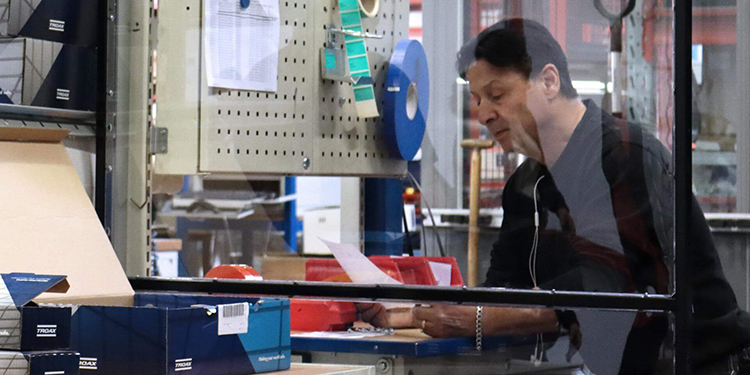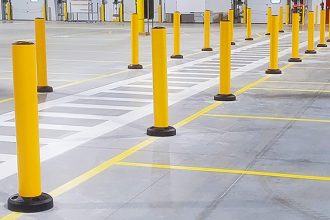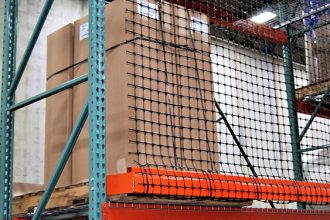Consider The Following When Specifying Industrial Social Distancing Barriers

As the COVID-19 pandemic continues to be a part of daily life for the foreseeable future, manufacturing, warehousing, and distribution operations continue to deploy a variety of polices, practices, and measures to safeguard their employees’ health and wellbeing. Among the many protocols instituted at such facilities are mask wearing, frequent cleaning and sanitization of workspaces, and social distancing—wherein employees are required to make every effort to stay at least 6 feet apart. All of these mandates are recommended by the U.S. Centers for Disease Control (CDC) and the Occupational Health and Safety Administration (OSHA). Additionally, these two agencies recommend the use of physical barriers for work situations where people cannot maintain 6 feet of separation, or in which the infection status of personnel is unknown.
While the barriers can shield personnel from large droplets generated by a sneeze or a cough, they should not be the sole method of employee protection, say the National Institutes of Health (NIH), CDC, and OSHA. The three agencies advise that, “Barriers should only be used in combination with physical distancing, face coverings and routine disinfection of high-contact surfaces.” That said, here are some considerations for operations looking to install such partitions.
Material. A variety of materials are available for the construction of physical barriers. Because both visibility and proper illumination are critical safety factors in industrial applications, most operations elect to install transparent partitions. For safety, the majority use a clear, see-through material that will not crack or shatter upon impact, such as plexiglass, polycarbonate, acrylic, or vinyl. Each material comes in different thicknesses or densities; in general, the thicker the material the more impact resistant and durable it is. Thicker materials can also potentially be installed or fabricated without a frame; thinner materials require a frame to minimize sagging and bowing, as well as for structural integrity.
Surface Properties. Depending on the type of material chosen for the barrier, its surface will react differently to the types of cleaning solutions used to disinfect and sanitize it. For example, the surface of plexiglass can be damaged by products that contain ammonia. Therefore, be sure to understand what types of products can be used to disinfect the barrier without causing damage, and train employees tasked with sanitization to use only that type of disinfectant. Additionally, because material surfaces can react differently to the variety of adhesives used on tapes, be cognizant of the potential for damage if allowing workers to stick signage on the barriers.
Sizing. Consider the personnel and the work area in which the barrier will be placed. If employees work standing up, a tall barrier will be needed. Seated tasks may not require quite so tall a barrier. Additionally, the NIH advises that the barrier dimensions exceed the breathing zones of the persons working on either side of the partition. The agency defines a breathing zone “as the zone within a 0.3 meters (or 10 inches) radius of a worker’s nose and mouth.”
Portability. Some operations prefer fixed partitions that are suspended from overhead. Others wish to affix them directly to a surface, such as a tabletop or counter. Additional options include free-standing barriers that extend to heights of 8 feet (or more) with the entire area covered by a clear polymer panel; partitions that provide shielding at the top but are open at the bottom for better airflow; or barriers on wheels that allow them to be moved to different locations as needed.
Stability. Free-standing barriers should be sufficiently weighted at the bottom to prevent them from tipping over or falling. Likewise, partitions with wheeled bases should also be weighted at the bottom for the same reason; the wheels should also lock to prevent the barrier from rolling away. If airflow is significant or an impact is likely, suspended partitions should be weighted at the bottom and installed in such a way as to minimize the chance of them swinging and possibly striking a worker.
Accessibility. Determine whether workers will need to pass an item between them; if so, consider incorporating a slot in the partition. This will minimize the need for employees to step around the barrier. This situation is most commonly found in shipping and receiving docks, where paperwork must be passed between drivers and employees. In such instances, the clear barriers can be integrated into the service window in driver cage.
Glare. Certain barrier materials will create a stronger glare than others. Take note of the location, position, and intensity of ambient lighting, light fixtures, windows, skylights, task lighting and other sources of illumination in the area in which the partitions are to be located. If the potential for strong glare exists, specify a material that will minimize its impact on employees.
Environment. Different partition materials are rated for specific temperature ranges. If barriers are to be used in locations other than ambient environments — such as cold or freezer storage applications or high heat processes — verify that the selected material can withstand the temperature in that area.
Placement. Be sure that the barriers are not placed in such a manner as to impede a user’s ability to escape the area in an emergency, or that they impede the regular flow of vehicle or pedestrian traffic.
Fire Rating. Verify that the barrier material chosen complies with the fire rating required by the local governing authority.
Looking for more information about guardrails and protective barriers? The members of the Protective Guarding Manufacturers Association (ProGMA) are available for guidance and recommendations.



